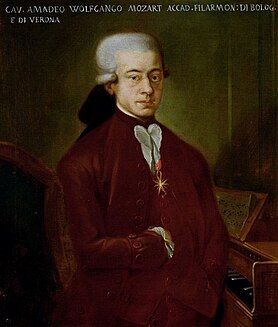
Carl Ditters von Dittersdorf was an Austrian composer, violinist and silvologist.

The Sinfonia Concertante for Violin, Viola and Orchestra in E-flat major, K. 364 (320d), was written by Wolfgang Amadeus Mozart.
The Symphony No. 98 in B♭ major, Hoboken I/98, is the sixth of the twelve London symphonies composed by Joseph Haydn. It was completed in 1792 as part of the set of symphonies composed on his first trip to London. It was first performed at the Hanover Square Rooms in London on 2 March 1792.

The Danish composer Carl Nielsen wrote his Symphony No. 3 "Sinfonia Espansiva", Op. 27, FS 60, between 1910 and 1911. Around 35 minutes in length, it is unique in his symphonic output for having vocal parts, specifically wordless solos for soprano and baritone in the second movement.

Wolfgang Amadeus Mozart's Horn Concerto No. 3 in E-flat major, K. 447, was completed between 1784 and 1787, during the Vienna Period.
Christoph Förster was a German composer of the baroque period.

Was mir behagt, ist nur die muntre Jagd, BWV 208.1, BWV 208, also known as the Hunting Cantata, is a secular cantata composed by Johann Sebastian Bach for the 31st birthday of Duke Christian of Saxe-Weissenfels on 23 February 1713. A performance lasts about forty minutes. The aria "Schafe können sicher weiden" is the most familiar part of this cantata.
Jiří Družecký was a Czech composer, oboist, and timpanist.
Ludwig van Beethoven's Rondo for Piano and Orchestra in B-flat major, WoO 6 was composed in 1793 and originally intended as the final movement for his second piano concerto. Hans-Werner Küthen states this was probably the finale for the first and second versions of the second piano concerto, being replaced by the final version of the rondo in 1795. He also notes that the most likely inspiration for the insertion of an andante section into the rondo is the concluding rondo of Mozart's Piano Concerto No. 22.
The Sinfonia Concertante in B flat major, by Joseph Haydn was composed in London between February and March 1792. The work is a sinfonia concertante with four instruments in the solo group: violin, cello, oboe and bassoon. It is believed to be a response to similar works composed by Ignaz Pleyel, a former student of Haydn's who London newspapers were promoting as a 'rival' to Haydn. In addition to the solo group the Sinfonia Concertante is scored for flute, 2 oboes, 2 bassoons, 2 horns, 2 trumpets, timpani and strings.

Johann Sebastian Bach composed the church cantata Falsche Welt, dir trau ich nicht, BWV 52, in Leipzig for the 23rd Sunday after Trinity. He led the first performance of the solo cantata for soprano on 24 November 1726.
Wolfgang Amadeus Mozart's Rondo in B-flat for Violin and Orchestra, K. 269/261a, likely was composed between 1775 and 1777 as a replacement finale for the K. 207.

The Sinfonia Concertante for Four Winds in E flat major is a work thought to be by Wolfgang Amadeus Mozart, for oboe, clarinet, horn, bassoon, and orchestra, K. 297b. He originally wrote a work for flute, oboe, horn, bassoon, and orchestra, K. Anh. 9 (297B), in Paris in April 1778. There is considerable debate about the relation of the work as it is performed today to this original work.
Graham Whettam was an English post-romantic composer.
Johann Pfeiffer was a German violinist, concert master and composer of the late baroque period.

The Oboe Concerto in E-flat major is an oboe concerto by Vincenzo Bellini, most likely composed in 1823. Bellini's only surviving concerto, the piece is also an important part of his limited instrumental output. Performances typically last between seven and eight minutes.
Johann Adam was a German violist and composer of the Baroque era.

Tafelmusik is a collection of instrumental compositions by Georg Philipp Telemann (1681–1767), published in 1733. The original title is Musique de table. The work is one of Telemann's most widely known compositions; it is the climax and at the same time one of the last examples of courtly table music.









